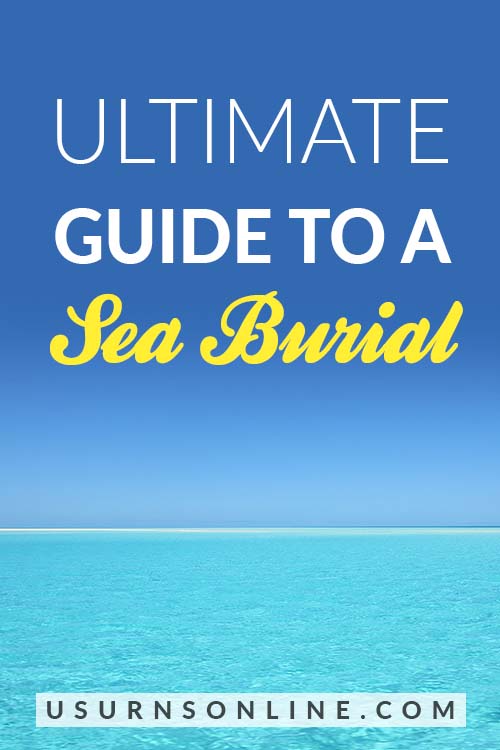Have you ever wondered if you could have a burial at sea? Some people find the idea very romantic and inspiring.
The good news is that an ocean burial is not just for pirates and sailors. It’s an option for anyone who loves the sea – or even the Great Lakes.
Continue to read and find if you are eligible to have your body or cremated remains buried at sea.
How to Have a Sea Burial
It is possible to receive a sea burial even if you’re not a military service member.
The most common type of burial at sea today is the scattering of cremated remains, but full body committal is also an option. Some rules will apply to both full body and cremation burials at sea.
All sea burials (whether cremated remains or the whole body) must be completed at a minimum of three nautical miles from shore and shall be reported within thirty (30) days to the EPA Regional Administrator of the region or locality where the vessel departed from shore.
From there, it’s simply a matter of finding a vessel that will help you with the ocean burial. You must, of course, also follow any local guidelines that apply.
Full Body Burial at Sea
Having a full body burial at sea is a long-honored tradition for any seafaring person. The interest in sea burials has risen especially among people focused on environmental burials. Ocean lovers, sailing enthusiasts, and fishermen may also want a send-off that requires being dropped into the sea.
U.S. law demands that a full-body burial at sea must take place in a location at least 600 feet deep as well as a minimum of three miles from shore. You will need to have a licensed funeral director on board.
Cremation Burial at Sea
You can bury your loved one’s cremated remains in the ocean by placing them in a biodegradable urn.
Urns Made in the USA
Biodegradable urns specifically made for burial at sea are crafted to float for a few minutes, then sink slowly to the deep. The urn will gently release the cremains and disintegrate completely around twenty-four hours after burial.
Cremation Ocean Scattering
The scattering of cremated remains at sea is becoming more and more common. This typically involves chartering a boat with a licensed sea captain. You can have a solemn affair or a bright and boisterous occasion.
Use a scattering urn to pour out the ashes. Some of the cremated remains will sink immediately, while other times the remains may float on the waves for a while.
Scattering cremated remains can be done legally along the coast of the United States. But you must remember the three-mile rule.
Why Do People Want to Be Buried at Sea?
There are numerous reasons why people choose to be buried at sea.
One of the biggest reasons is that people love the nautical history of burial at sea, and being connected to the past through this ancient tradition. Burial at sea has taken place for thousands of years. It dates back to ancient Egypt, Greece, and Rome, not to mention the Vikings.
Some people love the ocean, while others simply don’t want to be cremated or buried in the earth. The ocean is a vast, wide-open space, and many individuals prefer the idea of their remains being dispersed all over the world in the connected waterways of the seven seas.
Those who served in the military at sea, in the Navy or Coast Guard, often desire a sea burial. The same goes for anyone who spent much of their life sailing. This includes fishermen, anyone who worked on or captained a transport or cruise ship, boating enthusiasts, surfers, oil workers, marine biologists, scientific researchers, and many more hobbies and professions connected to the ocean.
Lastly, you may want to give back to nature after your death. When you are buried at sea, your body will supply food for sea life.
Burial at Sea: Practical Considerations
There are two ways to request burial at sea: through a civilian charter company or the U.S. Navy.
Navy Ocean Burial
A Navy burial is conducted while a ship is deployed. It will be arranged by the Navy, and family members cannot attend the ceremony.
The naval veteran will receive full military honors at sea. This will include the playing of Taps and the closing of colors. The American flag will fly at half-mast as the committal service is taking place.
The commanding Naval officer will send a letter to the family after the ceremony has taken place. This letter will include the date, time, and location where the committal ceremony took place. The Navy will include any photos that have been taken.
Civilian Ocean Burial
A civilian charter company will take the funeral director (if it is a full-body burial you must have a licensed funeral director) and the family out to sea to perform the ceremony.
Any materials placed in the water must easily biodegrade – metals and plastics are not allowed. No matter if you choose a full-body burial at sea or scattering cremated remains, the charter company will supply a certificate giving the coordinates of their final resting place.
What happens when a body is buried at sea?
A weighted body will normally float to the surface in about three to four days. The body is exposed to sea birds, sun, and waves. Scavenging creatures will feed on the corpse.
Within a week or two, the bones will sink. To fully decompose can take from three to six months.
Is it legal to be buried at sea?
Yes, it is legal to be buried at sea. But only humans may be buried at sea, not animals, so you cannot have a pet burial in the ocean.
Do you need a casket?
No, you do not need a casket. The less material going into the water, the better.
How much does burial at sea cost?
The average cost of a burial at sea ranges from $500 to $2,000.
Who qualifies for burial at sea?
Anyone qualifies and can have their body or cremated remains buried at sea. There is no need to have any connection to nautical life or the military.
Navy Burial at Sea Requirements
If you want a burial through the U.S. Navy, you must be:
- Honorably discharged, or actively serving in the service.
- U.S. civilian marine personnel of the Military Sealift Command.
- Dependent family members of active duty personnel, retirees, or veterans of the services
You will need:
- The burial at sea request form.
- The burial transit permit or the cremation certificate.
- A copy of the DD Form 214, discharge certificate, or retirement order.
- A photocopy of the death certificate.
EPA Regulations for Burial at Sea
The EPA has issued a general permit under the Marine Protection, Research and Sanctuaries Act (MPRSA) to authorize the burial of human remains at sea. You can read all the rules and regulations here.
Burial at sea is the most environmentally friendly burial available. There is no embalming fluid used, no crematory to light up, and no carbon footprint left. It is also an affordable disposition.
What to Say at a Sea Burial Service
What about an actual service at sea – what should you say and do?
While you may want to highlight the nautical aspect of the burial, the service itself can essentially be the same as a traditional burial (aka committal) or scattering ceremony.
- Opening prayer or remarks
- Scripture or other reading
- Brief eulogy
- Song/hymn or sharing of memories
- Final respects
- Committal
- Closing prayer or remarks
That would be about the longest service we would advise. Feel free to omit several elements as needed or desired.
You’ll want to plan to keep it short, especially since you should expect the elements such as sun, wind, ocean spray, and the rocking of the boat to cause distraction and discomfort.
Here are some resources to use for specific prayers and readings:
- Funeral Readings
- How to Write a Eulogy
- Scriptures for Funerals
- Prayers for Funerals
- Funeral Hymns
- Planning a Committal Service
- What to Say When Scattering Ashes
Let us close with the committal prayer from the 1662 Anglican Book of Common Prayer:
“We, therefore, commit the earthly remains of this body to the deep, looking for the general Resurrection in the last day, and the life of the world to come, through our Lord Jesus Christ; at whose second coming in glorious majesty to judge the world, the sea shall give up her dead; and the corruptible bodies of those who sleep in him shall be changed, and made like unto his glorious body; according to the mighty working whereby he is able to subdue all things unto himself. Amen.”
Pin It




